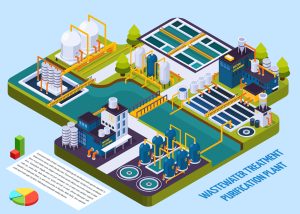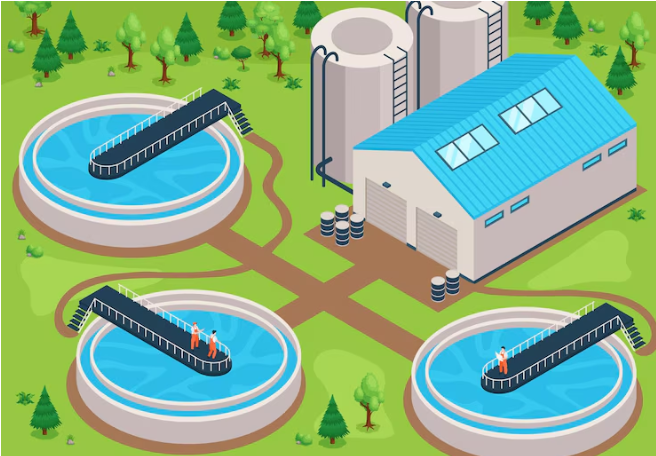Sewage Treatment Plants: Unveiling the Process, Stages, and Definition for Environmental Wellness
Explore the comprehensive Sewage Treatment Plants guide covering the process, stages, and definition. Learn how these crucial systems contribute.

Introduction
Sewage treatment involves purifying wastewater influent by eliminating contaminants, micro-organisms, and various pollutants.
The primary goal is to generate treated wastewater (effluent) and solid waste/sludge suitable for safe discharge into the natural environment. Dive into the intricacies of sewage treatment plants and understand their vital role in environmental preservation.
What are sewage treatment plants?
This wastewater treatment technique is intended to contain contaminated water in sections specifically made for that purpose.
Several steps in this plant’s operation involve removing waste from the influent wastewater.
Background information on the history
Sewage discharged directly
Although drainage systems were present in many ancient cities, their main purpose was to divert rainfall from pavements and roofs. The ancient Roman drainage system is one famous example.
The Cloaca Maxima, often known as the “Great Sewer,” was a vaulted tunnel that conveyed drainage water to the Tiber River. It was connected to numerous surface conduits. One of the largest and oldest surviving examples of Roman engineering is the Cloaca Maxima, constructed entirely of stone.
During the Middle Ages, there was not much advancement in sewers or urban drainage. Although there were privy vaults and cesspools available, most excrement was just thrown into gutters where floods would flush it down the drains.
In early 19th-century homes, toilets (also known as water closets) were erected, although these were typically connected to cesspools rather than sewers.
Local circumstances quickly grew unbearable in densely populated regions since cesspools were frequently flooded and emptied infrequently.
It became clear that public health was in danger. Cholera outbreaks in England during the mid-1800s were directly linked to well-water supplies tainted by human waste from cesspools and privy vaults.
In the larger towns, it quickly became necessary to connect all water closets directly to the storm sewers. This caused sewage to be moved from the ground close to homes to neighboring bodies of water. Thus, surface water pollution became a new issue.
Sewage Treatment Plant Process:
1. Preliminary Treatment:
The primary goal of this initial step of the sewage treatment plant process is to remove big materials and coarse sediments that are frequently present in raw wastewater. huge filter screens, grit cleaning, and even shattering huge items are also part of the preliminary treatment processes.
Overgrit clogs pumps severely, which impacts several more treatment pumps in the process. Before treatment, flow measurement instruments—typically standing-wave flumes—are invariably incorporated.
2. Primary Treatment:
This treatment’s primary goal is to lessen any heavy materials—both organic and inorganic—that sedimentate to the bottom while oil, grease, and lighter solids float to the top by skimming. After the settled and floating materials have been removed, the liquid that remains can either be released or go on to the next step, or secondary treatment. About 60% of the suspended particles in wastewater are removed during the first treatment.
3. Secondary Treatment:
The main goal is to remove dispersed and dissolved biological materials from the effluent after initial treatment. For sludge processing, secondary or biological sludge—the biological materials extracted during secondary sedimentation—is typically mixed with primary sludge.
Before discharge or tertiary treatment, secondary treatment may need a separation procedure to eliminate the microorganisms from the treated water. Over 90% of the suspended particles are eliminated by further treatment.
4. Tertiary/Advanced Treatment:
Tertiary treatment assists in removing wastewater elements that secondary treatment cannot remove, and it typically comes after secondary treatment.
Before treated wastewater is released into the receiving environment, it is occasionally chemically or physically cleaned (sea, river, lake, wetlands, ground, etc.)
Developments in sewage treatment
“It is the solution to pollution,” as the saying goes, was once said. Small amounts of sewage can naturally self-purify through stream flow when released into a flowing body of water.
However, sewage generation in densely populated areas is so high that contamination cannot be avoided by dilution alone. Because of this, wastewater must be somewhat treated or purified before being disposed of.
In the late 19th and early 20th centuries, centralized sewage treatment plants were built, mostly in the United States and the United Kingdom.
Sewage was first put through a series of physical, biological, and chemical procedures that eliminated some or most of the pollutants, as opposed to being dumped straight into a nearby body of water.
In the early 1900s, new sewage-collection systems were also developed to separate household wastewater from stormwater, preventing treatment plants from being overburdened during rainy seasons.
The public’s increasing concern for environmental quality after the mid-1900s resulted in expanded and stricter regulation of wastewater disposal procedures.
More intensive forms of care were needed. For instance, industrial wastewater pretreatment frequently became required to keep harmful compounds from interfering with the biological processes carried out in sewage treatment plants.
Advances in wastewater treatment technology have made it feasible to practically eliminate contaminants from sewage. However, because this was so costly, such high doses of treatment were typically not warranted.
Conclusion
Sewage Treatment Plants play a crucial role in safeguarding the environment by purifying wastewater. From ancient Roman systems to modern treatments, these plants have evolved.
The stages—Preliminary, Primary, Secondary, and Tertiary—highlight the meticulous processes involved. With a rich history and continuous innovations, Sewage Treatment Plants stand as vital guardians of environmental wellness, ensuring a cleaner and healthier future.



